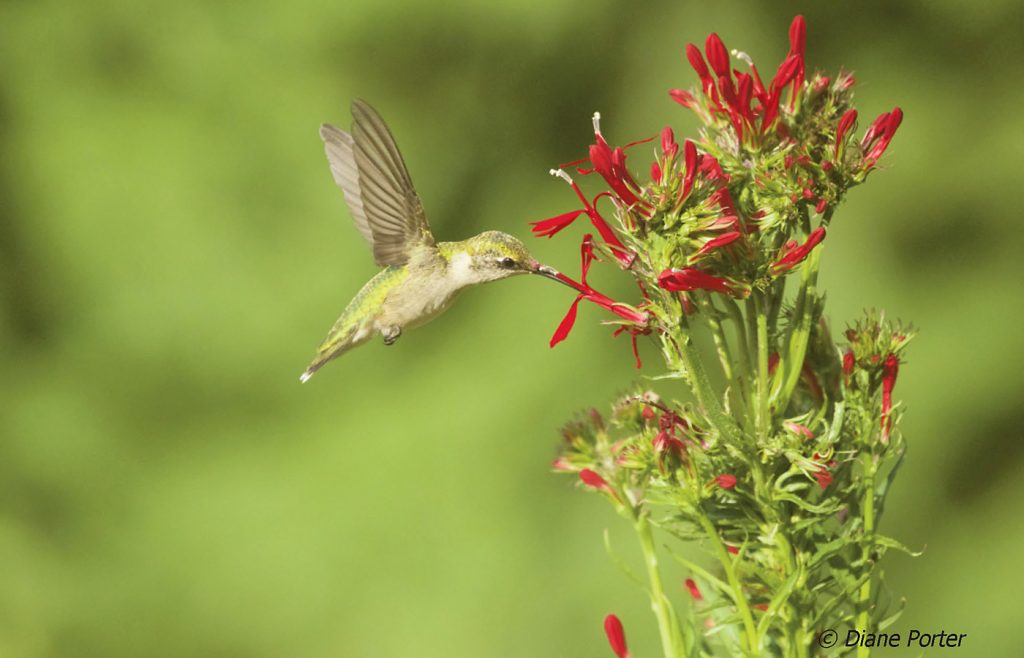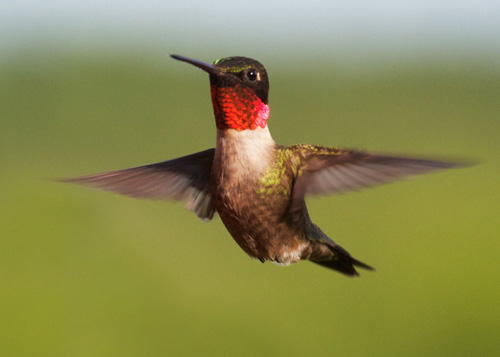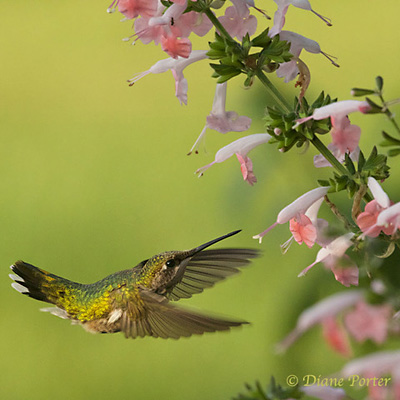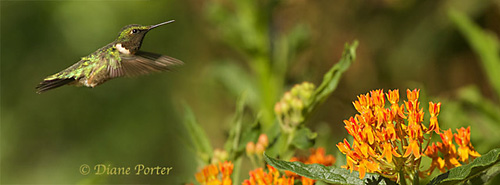
“Great Spirit created Hummingbird to be slightly different from other feathered creatures. Hummer sings a vibration of pure joy. Plants flower and live because of Hummingbird. Hummingbird can fly in any direction. It is said that Hummingbird conjures love as no other medicine does. Beauty is the target, and its mission is to spread joy . . . It quickly dies if caught or imprisoned.” —Jamie Sams, author of Medicine Cards: Discovery of Power Through the Ways of Animals
Sometimes in life you just hit the wall. For some of us, it’s a convergence of awful events that takes us down, a great loss, a health crisis, a toppling pile of stress, or a seemingly impossible situation that just has us paralyzed. Sometimes it takes a day, and sometimes it takes a decade, but usually, by faith, by force, or by miracle, we do reach a moment when we are able to begin rebuilding: accepting what was once unacceptable, healing our hearts, asking for help, even loving ourselves. Baby step by baby step, we stand up and step back into our lives.
Last summer, I held a hummingbird in my hand. Walking home from work after a rainstorm, as I passed the corner shop on the town square, I happened to look down at the sidewalk. There, lying on the pavement beneath the large storefront window, was a tiny green bird. It took a moment for my brain to register what I was seeing, and I gasped, “Oh no, little guy,” instinctively crouching down to get a closer look. The hummingbird seemed lifeless, and my heart sank. But a moment later I noticed his delicate grey feet were convulsing ever so slightly. “Oh God, he’s still alive,” I thought. Barely.

The likeliest story was that he’d flown straight into the glass window, believing it to be trees and sky, and had knocked himself out cold—or worse. Imagine hitting a wall at 30 or 40 miles per hour, bearing the brunt of the impact with a needle-sharp beak that’s roughly a third of your body length.
Afraid that he might get stepped on, I slowly, gently scooped up his limp body, barely bigger than my thumb, into the palm of my hand. He lay on his side, eyes closed, seemingly unaware of the transfer.
What do you do with a half-dead hummingbird? Without a plan, I started shuffling my feet homeward, talking to him as I painstakingly crossed the street and headed up the block. Flashes of a YouTube video popped into my head about a man and his dog that rescued an injured hummingbird—in the end this enormous dog and the bird had become best friends. Except I didn’t have a dog. How would this story end? I hoped against all hope that it wouldn’t end with me digging a hole in the ground.
About halfway down the next block, I noticed that his eyelids were beginning to twitch a little, and I sat down on the curb, wanting to give him my full attention. We rested there together for 20 precious minutes or so, and I reveled in seeing his fine features up close: his wrinkly grey eyelids, his smooth white belly, his iridescent green wings and tail, his tiny everything. “You’re just the sweetest little thing,” I must have said a hundred times.
Suddenly a whisper of movement caught my eye at the tip of his beak. His tongue was starting to flick out in little tiny licks, as if to taste the air. A minute later, his eyes began to flutter open. Could he see me? Was he hearing my voice? Did he feel safe?
After another minute or two, I followed an impulse to gently nudge his body into an upright position, with his feet tucked under him. He sat there and blinked a long while, and I took it as a hopeful sign when he started straightening out the muscles in his neck, raising his wobbly little head as if to take in a larger view beyond the cup of my hand. He seemed to become alert to noises around us, cars passing by on the street. I slowly stood up, watching his head weave around, his eyes trying to focus. I could feel him balancing in my palm, and I stopped again under a tree to be still.
Without warning, straight up he went into the air. With wings buzzing at lightning speed, he landed in an instant on a low branch of the tree. My heart filled with joy, and I laughed out loud as I studied him there just above me. His body lurched around below his wobbly head as he balanced on the branch, like a baby recently emerged from its egg. But the ease of his leap into the air gave me great confidence that he was going to make it. Flight, after all, was his nature. The rest was sure to follow.
I’ve since learned from local bird expert, photographer, and enthusiast Diane Porter that—despite their fragile appearances—hummingbirds are total badasses.
The Long Haul: Migration
Based on recent discoveries by oilrig workers in the middle of the Gulf of Mexico, it has now been proven that a vast number of the ruby-throated hummingbirds that migrate to Iowa in early May don’t follow the curve of land across Mexico. Each spring they take a huge leap of faith, crossing over 500 miles of gulf waters from the Yucatan Peninsula to the southern coast of the U.S. They take off in the afternoon and fly all night long, “guided by the stars, maybe by the wind, maybe the magnetism of the earth—we don’t yet know all the ways they use to navigate,” Diane explained to me, with wonder in her voice.
Sometime in the middle of the next morning they make landfall on the gulf coast, desperate for food and rest, depleted of every ounce of fat, some beginning to burn through muscle in order to make it. Some never get there, but for the ones who do, it’s an absolute feeding frenzy.
“Often times, if you’re along the gulf coast when they’re migrating, you’ll see them,” says Diane. “It’s called the Yucatan Express because of the hummingbirds, and other birds too, just coming in. And of course that’s when the trees are all starting to leaf out and they got all the bugs on ’em.”
Gnats & Red Flowers
Well, you can imagine after a flight across the ocean those birds need to put a little meat back on their bones, but I was surprised to learn from Diane that one of the staples of their diets is indeed insects. Small ones. Tiny gnats and such. You may have noticed in hummingbird aviaries and the like that plates of rotting fruit are often left out in the open air. The fruit ain’t for the birds. A mushy banana is the perfect breeding ground for fruit flies. Bird protein!

And of course the other food they love? Flower nectar. “They’re following the opening of the flowers as they go north,” explains Diane. They’ll drink nectar from many different kinds of flowers, but their absolute favorites are the red ones! “Somebody speculated that every speck of red in North America gets investigated by a hummingbird,” says Diane. (No wonder every ugly hummingbird feeder you see for sale is made from red plastic!) “And if you’re wearing red, too, they’ll come and investigate you,” she adds.
So if you want more of these wonderful creatures to hang out in your yard, “what you really want is to grow flowers,” says Diane. Hummingbirds especially love columbines. “The ones that are native to the Midwest, Aquilegia canadensis are the pinky-red ones,” Diane says. Each one of its five long spurs has a reservoir of nectar in it. The hummingbird puts its bill in, and with its long tongue, is able to reach the nectar. “It’s thought the hummingbird and the columbine evolved together,” adds Diane.
“I can time it within a few days: when the columbines in my yard are open, the hummingbirds will be there within a couple of days.”
The other flower they apparently just go nuts about is not a native: pink-colored Coral Nymph salvia, Salvia coccinea. Diane admits, “Even though I’m very interested in preserving native plants” (in fact, she’s slowly getting rid of all non-natives in her yard and gardens), “I still grow that Coral Nymph salvia because the hummingbirds absolutely love it!”

If you are serious about attracting hummingbirds, “you want big, dense masses of red flowers,” says Diane. “But if you want the fun of having them up close, get a feeder. You can start out by putting the feeder in the bed of flowers and then moving it a little closer. In fact, if you have a little time to spend, you can get them to eat out of your hand. I’ve had them drinking the nectar water out of the feeder that I’m holding . . . You can feel the whir of their wings on your face, and when they’re all buzzing around you it’s quite thrilling.” The hum of a hummingbird.
Sugar Water Feeders
If you do decide to invest in some feeders, just know that it’s quite a commitment. Dissolving one part sugar in four parts boiling water sounds easy enough. Sugar isn’t costly. But it’s crucial to change your homemade nectar out about every other day. Clear nectar and clean feeders are super important. “The feeders are for us, not them,” says Diane, “and we have to take it really seriously to keep those suckers clean.” Fermented sugar water, even just a few days too old, can make a hummingbird sick, so Diane keeps two feeders on hand. When one is outdoors full of fresh nectar, the other is in the dishwasher. It’s one benefit of having plastic feeders!
Are there other kinds of hummingbirds here in Iowa besides the ruby-throated Archilochus colubris? “Occasionally you’ll hear of someone reporting a sighting of another kind of hummingbird, but it’s some poor lost soul,” says Diane. “They’re not where they belong. Not that I wouldn’t drop everything to go and see one!”
The Nest You’ll Never See
The ruby-throated hummingbirds will be here all summer long, drinking flower nectar, eating bugs, and making babies. A hummingbird nest, however, is a rare find. These little hummers are masters of camouflage, covering the outside of their walnut-sized nests with lichen from the host tree. The nesting material itself is made from downy spider webs, collected by mom and dad. Eggs are barely the size of a Tic Tac.
“In the late summer you’ll have the most numbers after they’ve fledged,” says Diane. “You’ll have every pair that made it across the waters and their two babies.”
Taking Flight
That beautiful little bird I held in my hand last summer (which I found out later was likely a young male or an adult female) gave me a great deal of hope during a pretty rough time. Later that day I remembered a birthday gift I’d once received: a deck of Medicine Cards inspired by Native American folklore, created by Jamie Sams. Each card features a delicate illustration of an animal, accompanied by a description of its innate qualities and its message (or “medicine”), meant to illuminate wisdom or to guide. One quiet morning, I spread out my medicine cards face down to draw from the pile, seemingly at random, my personal “spirit guides.” What did the animal kingdom have to teach me about myself? The first card I turned over was the hummingbird.
To this day, its description gives me great comfort, delight even, and permission to be myself. That’s some pretty good medicine.
A few hours after I said farewell to my wobbly, winged friend that day, I pondered the possibility that I, too, would soon be taking to the air again, finding beauty, and spreading joy.
